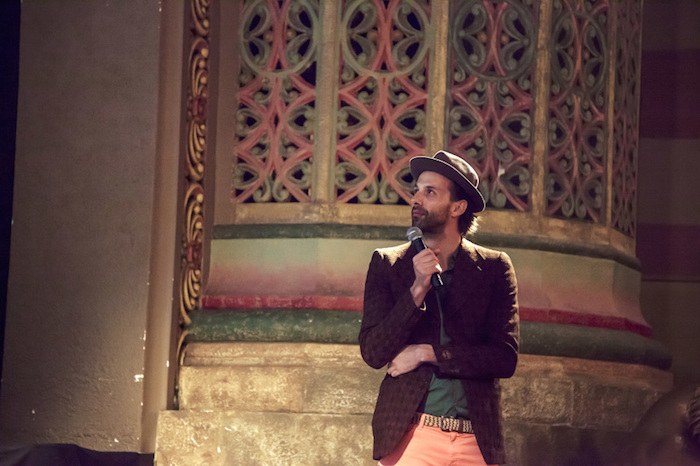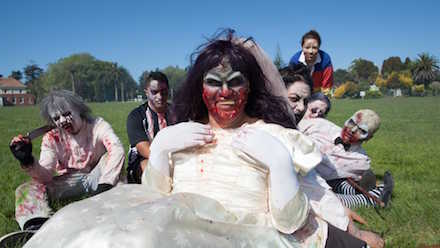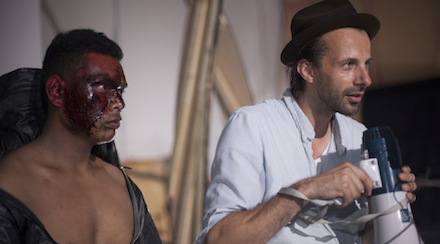SPOOKERS: THE FLORIAN HABICHT INTERVIEW
 Sunday, August 13, 2017 at 6:57AM
Sunday, August 13, 2017 at 6:57AM Florian Habicht is a truly idiosyncratic, determinedly personal filmmaker. Florian settled into the Auckland art scene after his family immigrated to New Zealand from Germany in the 1980s. His films have run the gamut from magical realism (Woodenhead, 2003) to edgy romance (Love Story, 2011); his documentary Pulp: A Film About Life, Death and Supermarkets (2014) captured the return of the iconic band to their hometown. His latest film is Spookers, an unexpectedly moving (and, yes, occasionally terrifying) study of the folks who provide the frights at the New Zealand ‘scare park’, one of the largest of its kind in the world.

As his film continues its global rollout after festival slots in Sydney, Canada’s Hot Docs and Auckland, Florian Habicht spoke with SCREEN-SPACE about his latest walk on the weird side…
SCREEN-SPACE: How did the Spookers project come to you? How did you determine this was to be your next film?
 HABICHT: I was really determined not to make Spookers (laughs). Suzanne (Walker, producer) from Madman Entertainment dreamt up the idea. I got a phone call from them with the pitch, because they wanted to make the film with a New Zealand director. I was in the middle of writing a drama that I was, and am, really passionate about and I was coming off making a lot of docos. So I went to Spookers with a camera to do a few test shots, hoping that I wouldn’t like it and it would be easy to say no. But once there, I just fell in love with the place and especially the performers. I immediately realised that the building where it all takes place was an old psychiatric hospital. When you drive onto the grounds, there is an epic, very intense sensation, a bit like The Shining.
HABICHT: I was really determined not to make Spookers (laughs). Suzanne (Walker, producer) from Madman Entertainment dreamt up the idea. I got a phone call from them with the pitch, because they wanted to make the film with a New Zealand director. I was in the middle of writing a drama that I was, and am, really passionate about and I was coming off making a lot of docos. So I went to Spookers with a camera to do a few test shots, hoping that I wouldn’t like it and it would be easy to say no. But once there, I just fell in love with the place and especially the performers. I immediately realised that the building where it all takes place was an old psychiatric hospital. When you drive onto the grounds, there is an epic, very intense sensation, a bit like The Shining.
SCREEN-SPACE: Are you a fan of horror, in any form?
HABICHT: Oh God, no. The exact opposite! I’d never been to Spookers, never decided to make that trip, because I knew I’d just be too scared. But I knew it would be a great setting for a film. When I finally did do the tour, I had a video camera in my hand. Now, I went paragliding with a camera in my hand once and everything was totally sweet, but the thought of paragliding without a camera…just, no way. It was the same when I went through Spookers.
SCREEN-SPACE: Given that it is set in Kingseat, an old and abandoned asylum with its own dark past, were you at all conscious of how you depict the link between violence and mental health?
 HABICHT: I went to a great café in Auckland called Hallelujah, which no longer exists, and I saw a young woman reading a book on mental health. I decided to talk with her, mostly because the cover of the book looked so cool, and it turned out she was studying to be a nurse and her mental health professor had been at Kingseat. That was Deborah, one of those featured in the film, and we are good friends now. Many of the people who had been at Kinsey were not really into talking about that experience on camera, but Deborah was very open. I don’t believe you could make a film about Spookers and not make it about mental health.
HABICHT: I went to a great café in Auckland called Hallelujah, which no longer exists, and I saw a young woman reading a book on mental health. I decided to talk with her, mostly because the cover of the book looked so cool, and it turned out she was studying to be a nurse and her mental health professor had been at Kingseat. That was Deborah, one of those featured in the film, and we are good friends now. Many of the people who had been at Kinsey were not really into talking about that experience on camera, but Deborah was very open. I don’t believe you could make a film about Spookers and not make it about mental health.
SCREEN-SPACE: Did the owners Beth and Andy (pictured, right) trust you to represent them and their business positively? Did they have much say in how their story is told?
 HABICHT: I had a sense that Andy was a bit suspicious about what we were up to. Beth and I had a nice connection right from the start, which provided a few sparks in our interviews. They were both incredibly generous with their time and understanding, helping the crew over the shoot, which amounted to 30 days over the course of a year. The long shoot allowed the story to evolve as we edited, which is why (editors) Peter O’Donoghue and Veronica Gleeson are credited as writers, because we shaped the doco’s narrative in the editing. What was funny was that to get the funding we had to pretend that we knew what the film was going to be about. So we wrote a treatment that I knew was definitely not going to be the film. I probably shouldn’t say that (laughs), but that’s what you’ve got to do to complete a funding application. So there was that film, then there was the film that formed by going out there and experiencing the Spookers world.
HABICHT: I had a sense that Andy was a bit suspicious about what we were up to. Beth and I had a nice connection right from the start, which provided a few sparks in our interviews. They were both incredibly generous with their time and understanding, helping the crew over the shoot, which amounted to 30 days over the course of a year. The long shoot allowed the story to evolve as we edited, which is why (editors) Peter O’Donoghue and Veronica Gleeson are credited as writers, because we shaped the doco’s narrative in the editing. What was funny was that to get the funding we had to pretend that we knew what the film was going to be about. So we wrote a treatment that I knew was definitely not going to be the film. I probably shouldn’t say that (laughs), but that’s what you’ve got to do to complete a funding application. So there was that film, then there was the film that formed by going out there and experiencing the Spookers world.
SCREEN-SPACE: It is an inspired decision to intersperse the real-world narrative with the dream sequences of those at the centre of the Spookers story…
HABICHT: I held workshops with the eight performers. I took my hat off, placed it in the middle of the room, and just kept asking them all sorts of questions that they anonymously supplied answers to by dropping bits of paper in my hat. Questions like, ‘The last thing that broke your heart’ or ‘The last thing that made you cry’ or ‘What you had for breakfast.’ It was just to get to know them more. And a lot of the responses concerned their dreams, which I knew had to make up a part of any film that was going to tell their stories. Which then led to them taking their self-taught acting skills, the skills they use everyday at Spookers, to another level on-screen. That was really cool for them.
SPOOKERS will be released in Australian cinemas on September 14; New Zealand and international release dates to be confirmed.
 Documentary,
Documentary,  Horror,
Horror,  New Zealand
New Zealand 

















